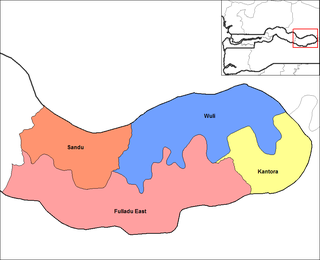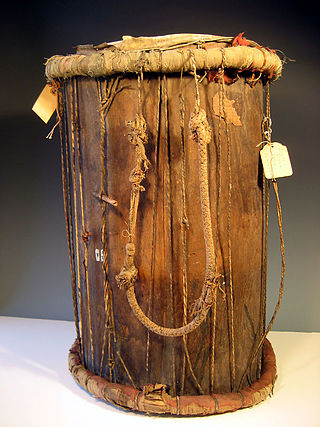
The Kingdom of Saloum was a Serer kingdom in present-day Senegal and parts of Gambia. The precolonial capital was the city of Kahone. Its history, geography and culture was intricately linked with the sister state, the Kingdom of Sine, and it was common to refer to them as the Sine-Saloum or the Serer Kingdoms.
Kahone or Kawon is a town and urban commune near Kaolack, Senegal. It was the capital of the pre-colonial Kingdom of Saloum and is a center of Serer culture and history.
Alvise Cadamosto (Portuguese pronunciation:[alˈvizɨkɐðaˈmoʃtu]; Italian pronunciation:[alˈvizeˌkadaˈmosto])(c. 1432 – 16 July 1483) was a Venetian explorer and slave trader, who was hired by the Portuguese prince Henry the Navigator and undertook two known journeys to West Africa in 1455 and 1456, accompanied by the Genoese captain Antoniotto Usodimare. Some have credited Cadamosto and his companions with the discovery of the Cape Verde Islands and the points along the Guinea coast from the Gambia River to the Geba River, the greatest leap in the Henrican discoveries since 1446. Cadamosto's accounts of his journeys, including his detailed observations of West African societies, have proven invaluable to historians.

Albreda is a historic settlement in the Gambia on the north bank of the Gambia River, variously described as a 'trading post' or a 'slave fort'. It is located near Jufureh in the North Bank Division and an arch stands on the beach connecting the two places. As of 2008, it has an estimated population of 1,776.

Basse Santa Su, usually known as Basse, is a town in the Gambia, lying on the south bank of the River Gambia. The easternmost major town in the nation, it known for its important market. Basse is the capital of the Upper River Division, which is coterminous with the Basse Local Government Area. As of 2009, the town has an estimated population of 18,414. According to the 2013 census, the Basse LGA has 243,791 residents.
Nuno Tristão was a 15th-century Portuguese explorer and slave trader, active in the early 1440s, traditionally thought to be the first European to reach the region of Guinea. Legend has it that he sailed as far as Guinea-Bissau, however, more recent historians believe he did not go beyond the Gambia River.

The Senegambian stone circles, or the Wassu stone circles, are groups of megalithic stone circles located in the Gambia north of Janjanbureh and in central Senegal. Spread across a region 30,000 km2 (12,000 sq mi), they are sometimes divided into the Wassu (Gambian) and Sine-Saloum (Senegalese) circles, but this is purely a national division. Containing over 1,000 stone circles and tumuli spread across an area 350 km (220 mi) long and 100 km (62 mi) wide, the Senegambian stone circles are the largest concentration of stone circles seen anywhere in the world, and they are an extensive sacred landscape that was used for more than 1,500 years. The sites were inscribed on the UNESCO World Heritage List in 2006.

Central River is the largest of the five administrative divisions of the Gambia. Its capital is Janjanbureh, on MacCarthy Island. The largest settlement is Bansang, with an estimated population in 2008 of 8,381.
Kuntaur is a town located in central part of the Gambia.

Lower Saloum is one of the ten districts of the Central River Division of the Gambia. Its population in the 2013 census was 15,881.

Upper Saloum is one of the ten districts of the Central River Division of the Gambia. In the 2013 census, it had a population of 19,145.

Fulladu East was one of the four districts of the Upper River Division of the Gambia. The Upper River Division is now the Basse Local Government Area, and the former Fulladu East District is now divided into a Basse Fulladu East District, a Jimara District and a Tumana District.

Foundiougne department is one of the departments of Senegal, located in the Fatick region.

The Serer people are a West African ethnoreligious group. They are the third-largest ethnic group in Senegal, making up 15% of the Senegalese population. They also reside in northern Gambia and southern Mauritania.
The Niominka people are an ethnic group in Senegal living on the islands of the Saloum River delta. They are currently classified as a subgroup of the Serer.
Sine-Saloum is a region in Senegal located north of the Gambia and south of the Petite Côte. It encompasses an area of 24,000 square kilometers, about 12% of Senegal, with a population in the 1990s of 1,060,000.

The medieval history of the Serer people of Senegambia is partly characterised by resisting Islamization from perhaps the 11th century during the Almoravid movement, to the 19th century Marabout movement of Senegambia and continuation of the old Serer paternal dynasties.

Joof or Diouf is a surname that is typically Serer. This surname is also spelt Juuf or Juf.
This is a timeline of the history and development of Serer religion and the Serer people of Senegal, The Gambia and Mauritania. This timeline merely gives an overview of their history, consisting of calibrated archaeological discoveries in Serer countries, Serer religion, politics, royalty, etc. Dates are given according to the Common Era. For a background to these events, see Roog, Serer religion, Serer creation myth, Serer prehistory, Lamane, States headed by Serer Lamanes, Serer history and Serer people.
Fenda Lawrence, was an African slave trader who operated in the Saloum town of Kaur. In 1772, she visited the Thirteen Colonies as a free black woman for both tourism and to trade.











